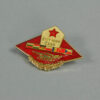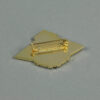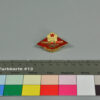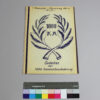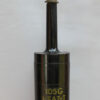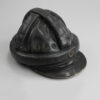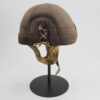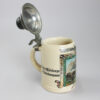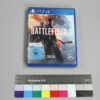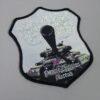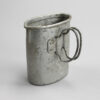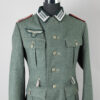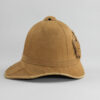Maneuver badge ŠTÍT 1984
Inventory number: DPM 3.2550
The ŠTÍT (Czech for “shield”) maneuver took place in September 1984 on the soil of Czechoslovakia and the GDR. The participants received a manoeuvre badge depicting all the flags of the participating states of the Warsaw Treaty Organization: Bulgaria, Hungary, the GDR, Poland, Romania, the Soviet Union and Czechoslovakia. ŠTÍT 1984 was a large-scale exercise in which the soldiers were particularly mobile and moved through the entire territory of Czechoslovakia within a short period of time: the exercise began in the heart of Slovakia and ended near the GDR border in the west of the Czech Republic.
The NVA of the GDR was represented by motorized rifle divisions, among others, which practiced an attack across the Elbe together with the Czechoslovak People’s Army, including the capture of bridgeheads. The maneuver badge of our collection was awarded to a driver of a T-55 TK, a crane and recovery tank of the NVA. The vehicle was normally only manned by two people, the commander and the driver; a mechanic was only to be added in the event of war. During the exercise, they took over the task of recovering tanks on the banks of the Elbe that failed to cross the river and got stuck. The T-55 TK itself was not allowed to cross the river, as this was considered too dangerous due to the crane superstructure.
As a rule, the large-scale maneuvers did not reflect realistic operational conditions. In the event of a war with the NATO states, each state of the Warsaw Treaty Organization would have initially operated from its own territory. There were no plans for the armed forces to mix and for the states to fight together.
On the contrary, it was even planned to have Soviet Union units operate between the units of the contracting parties in order to prevent communication between them and ensure control over them.
Compared to the manoeuvres in the 1960s, in which operations were carried out under nuclear conditions in accordance with the offensive doctrine, the focus of the exercises of the 1980s was more on ensuring coordinated cooperation at the organizational and, above all, information level: In the nuclear age, reliable transmission of orders in the shortest possible time was essential for survival.
However, joint exercises also always had a political dimension. This included not only military deterrence to the outside world, but also the creation of a sense of community within the alliance. The maneuvers were therefore accompanied by various evening events such as balls, concerts, celebratory dinners and troop parades. While in the 1960s the local population was still heavily involved in the supporting events and welcomed the soldiers of the allied armies, sometimes with marches, the interest of the population and the press in the maneuvers of the 1980s waned.
Object of the month
(short) stories from the depot
Unfortunately, many objects cannot currently be shown in the exhibition for conservation reasons. Here you will find unusual objects and exciting stories of special pieces from the depot


